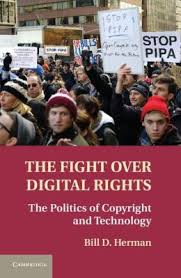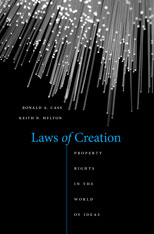 THE FIGHT OVER DIGITAL RIGHTS: THE POLITICS OF COPYRIGHT AND TECHNOLOGY, by Bill D. Hermann. New York: Cambridge University Press. 2013. 258pp. Cloth $95.00. ISBN: 9781107015975.
THE FIGHT OVER DIGITAL RIGHTS: THE POLITICS OF COPYRIGHT AND TECHNOLOGY, by Bill D. Hermann. New York: Cambridge University Press. 2013. 258pp. Cloth $95.00. ISBN: 9781107015975.  LAWS OF CREATION: PROPERTY RIGHTS IN THE WORLD OF IDEAS, by Ronald A. Cass and Keith N. Hylton. Cambridge: Harvard University Press. 288pp. Cloth $55.00. ISBN 9780674066458.
LAWS OF CREATION: PROPERTY RIGHTS IN THE WORLD OF IDEAS, by Ronald A. Cass and Keith N. Hylton. Cambridge: Harvard University Press. 288pp. Cloth $55.00. ISBN 9780674066458.Editor’s introduction and review by Paul Parker, Department of Political Science, Truman State University.
pp.634-636
In June of 2013 I distributed a call for reviewers for a symposium on intellectual property. The call produced several reviewers and a lead for another; no one had to be turned away. I had hoped for a larger response: intellectual property is a field directly affecting our interactions with the exchange and entertainment economies, argued in political and economic theoretical terms. It is a field whose contours are being significantly pressured by consumers’ behavior, content providers, device manufacturers, and content deliverers as they attempt to adapt to this changing world.
Much of this battle is well described in THE FIGHT OVER DIGITAL RIGHTS: THE POLITICS OF COPYRIGHT AND TECHNOLOGY, by Bill Hermann (2013). Hermann traces successive legislative and judicial attempts of entertainment companies to maintain control over their property: the recording industry in the face of cassette tape recorders, the motion picture and broadcast industries in the face of video cassette recorders and cd recorders, and more recently all digital media in an age of internet peer-to-peer sharing. Hermann characterizes the battle as one of Strong Fair Use proponents (e.g., Lessig, 2004) vs. the industries’ Strong Copyright proponents. He presents the history of content providers to control their property via legislation (eg, the Digital Millennium Copyright Act) and technology (Digital Rights Management, or DRM). It is an interesting story of an industries securing strong copyright provisions through law, only to see their technological locks (DRM) swiftly broken and their legal enforcements creating backlash among their consumer population.
Hermann demonstrates little sympathy for the Recording Industry and the Motion Picture Industry, suggesting that one former executive had confided in him that the industry had been rife with excess, which is an odd argument about property rights. More helpfully, he recounts numerous examples in which companies seem to have overplayed their hands, such as suing for fees for illegal downloading that far surpassed the market value of the “stolen” property (for more on the scare quotes, and on the odd manner in which intellectual property fits into traditional property law, see Roger Shiner’s review of 13 WAYS TO STEAL A BICYCLE). And famously, Sony used a DRM on compact discs that installed hidden software on [*635] the computers of people who had legally purchased their product. The software blocked copying of discs (fair use advocates argue for the ability to make copies for personal use), and the software also communicated the consumer’s listening habits with Sony. Sony’s DRM also allegedly violated the copyright of several other software programs.
Hermann is a professor in a Media and Film Studies department, with a doctorate in Communication. Many readers will recognize his sources as belonging to the “copyleft”: Wired, the Electronic Frontier Foundation, and BoingBoing.net are several sites and organizations that are Strong Fair Use advocates. While Hermann presents a battle between Strong Fair Use and Strong Copyright, Ronald Cass and Keith Hylton frame the debate essentially as between “creators and copiers” (p.217). In LAWS OF CREATION: PROPERTY RIGHTS IN THE WORLD OF IDEAS, Cass and Hylton indicate that there needed to be a corrective to the “Free Culture” argument of Lessig (2004), et al. They have written it, providing a theory of property (ch.2), and discussing how intellectual property is both similar and different (ch. 3). Especially in the digital age, when a good is “nonrival” – with a file transfer, you can add to my music collection without diminishing your own collection – the theories and laws underpinning real property seem outdated. But Cass and Hylton, in discussing IP’s branches of Patent Law, Trade Secrets, Copyright, and Trademark, strongly argue for the law’s need to preserve economic incentive of creators.
These books can usefully be read together: consumers should have an expectation that when they purchase a good or service, whether coffee or a movie, that product will not give them third degree burns or infect their computer. And if I really own my copy of Barry Manilow’s MANDY, I should be able to make copies for personal use on different devices. But I did not buy a license to distribute this to the larger public (I recognize this is a poor analogy, for there would be few who want MANDY that do not already have it. Still, the larger point remains). This is where Cass and Hylton’s discussion of a larger public interest in having secure copyrights is relevant.
But the willingness of Cass and Hylton to speculate that even the Copyright Term Extension Act of 1998, whose extended copyright terms applied retroactively, served the public interest, seems to rebut their own conclusion that copyright need not be zero sum. Derisively known as the Mickey Mouse Protection Act, the act was adopted five years before Steamboat Willie (a Mickey Mouse predecessor) would have entered the public domain. The Supreme Court rebuffed a constitutional challenge to the 1998 Act, and now, 10 years into the 20 extension favoring Disney, observers expect Disney, et al., to again push for further legal protection; it remains an empirical question whether lawmakers will once again comply. Even if the copyright expires, Disney still owns the trademark.
As Professor Angela Narasimhan writes in her review of Sunder, FROM GOODS TO A GOOD LIFE, “it would come as no surprise that contemporary intellectual property law … primarily … advance[s] the interests and fortunes of [*636] those already in possession of wealth, access, and power.” Sunder argues for a reframing of property law that would fit more closely with Hermann’s Strong Fair Use view: intellectual property ‘promoting human development rather than economic values,’ as Sunder writes.
The other two works under review in the symposium also reflect this goal cultural creativity. INTELLECTUAL LIBERTY: NATURAL RIGHTS AND INTELLECTUAL PROPERTY, by Hugh Breakey, argues for a restriction on property rights that would allow creative use by others. Reviewers Stephen McJohn and Lorie M. Griffin tell us that Breakey goes beyond the producer-consumer dichotomy that often marks copyright discussions, and as seen in Cass and Hylton. Finally, Mathew Manweller reviews RECLAIMING FAIR USE: HOW TO PUT BALANCE BACK IN COPYRIGHT, by Patricia Aufderheide and Peter Jaszi. Aufderheid and Jazsi identify, once again, the tension between producers and consumers, and attempt to offer a solution. Professor Manweller is appropriately skeptical: “If there is any weakness to this text it might be that it relies on a silver bullet theory that crafting mutually agreed upon fair use codes will solve most copyright battles.” In the absence of mutually agreed upon codes, law and litigation can be expected to continue.
REFERENCE:
Lessig, Lawrence. 2005. FREE CULTURE: THE NATURE AND FUTURE OF CREATIVITY. Penguin Books.
Copyright 2013 by the Author, Paul Parker.